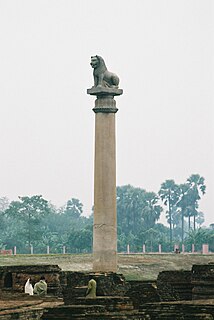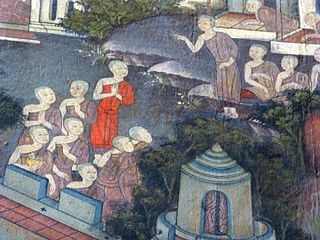Related Research Articles

The Sutta Pitaka is the second of the three divisions of the Tripitaka or Pali Canon, the Pali collection of Buddhist writings of Theravada Buddhism. The other two parts of the Tripiṭaka are the Vinaya Piṭaka and the Abhidharma Piṭaka. The Sutta Pitaka is also known as 'Buddhavachana' or words of Buddha and contains more than 10,000 suttas (teachings) attributed to the Buddha or his close companions.

Subhūti was one of the ten principal disciples of the Buddha. In Theravada Buddhism he is considered the disciple who was foremost in being "worthy of gifts" and "living remote and in peace". In Mahayana Buddhism, he is considered foremost in understanding emptiness.

Rāhula was the only son of Siddhārtha Gautama, and his wife, princess Yaśodharā. He is mentioned in numerous Buddhist texts, from the early period onward. Accounts about Rāhula indicate a mutual impact between Prince Siddhārtha's life and the lives of his family members. According to the Pāli tradition, Rāhula was born on the day of Prince Siddhārtha's renunciation, and was therefore named Rāhula, meaning a fetter on the path to enlightenment. According to the Mūlasarvāstivāda tradition, and numerous other later sources, however, Rāhula was only conceived on the day of Prince Siddhartha's renunciation, and was born six years later, when Prince Siddhārtha became enlightened as the Buddha. This long gestation period was explained by bad karma from previous lives of both Yaśodharā and of Rāhula himself, although more naturalistic reasons are also given. As a result of the late birth, Yaśodharā needed to prove that Rāhula was really Prince Siddhārtha's son, which she eventually did successfully by an act of truth. Historian H.W. Schumann has argued that Prince Siddhārtha conceived Rāhula and waited for his birth, to be able to leave the palace with the king and queen's permission, but Orientalist Noël Péri considered it more likely that Rāhula was born after Prince Siddhārtha left his palace.
Śrāvaka (Sanskrit) or Sāvaka (Pali) means "hearer" or, more generally, "disciple". This term is used in Buddhism and Jainism. In Jainism, a śrāvaka is any lay Jain so the term śrāvaka has been used for the Jain community itself. Śrāvakācāras are the lay conduct outlined within the treaties by Śvetāmbara or Digambara mendicants. "In parallel to the prescriptive texts, Jain religious teachers have written a number of stories to illustrate vows in practice and produced a rich répertoire of characters.".

Śāriputra was one of the top disciples of the Buddha. He is considered the first of the Buddha's two chief male disciples, together with Maudgalyāyana. Śāriputra had a key leadership role in the ministry of the Buddha and is considered in many Buddhist schools to have been important in the development of the Buddhist Abhidharma. He frequently appears in Mahayana sutras, and in some sutras, is used as a counterpoint to represent the Hinayana school of Buddhism.

Jetavana was one of the most famous of the Buddhist monasteries or viharas in India. It was the second vihara donated to Gautama Buddha after the Venuvana in Rajgir. The monastery was given to him by his chief male patron, Anathapindika.
Sigalovada Sutta is the 31st Sutta described in the Digha Nikaya. It is also known as the Sīgāla Sutta, the Sīgālaka Sutta, the Siṅgālovāda Sutta, and the Sigālovāda Suttanta.

Buddhist ethics are traditionally based on what Buddhists view as the enlightened perspective of the Buddha. The term for ethics or morality used in Buddhism is Śīla or sīla (Pāli). Śīla in Buddhism is one of three sections of the Noble Eightfold Path, and is a code of conduct that embraces a commitment to harmony and self-restraint with the principal motivation being nonviolence, or freedom from causing harm. It has been variously described as virtue, moral discipline and precept.
Khema was a Buddhist bhikkhuni, or nun, who was one of the top female disciples of the Buddha. She is considered the first of the Buddha's two chief female disciples, along with Uppalavanna. Khema was born into a royal family in Sagala, modern day Sialkot in Punjab, Pakistan. She was the wife of King Bimbisara of the ancient Indian kingdom of Magadha. Khema was convinced to visit the Buddha by her husband, who hired poets to sing about the beauty of the monastery he was staying at to her. She attained enlightenment as a laywoman while listening to one of the Buddha's sermons, considered a rare feat in Buddhist texts. Following her attainment, Khema entered the monastic life under the Buddha as a bhikkhuni. According to Buddhist tradition, the Buddha declared her his female disciple foremost in wisdom. Her male counterpart was Sariputta.

Uppalavanna was a Buddhist bhikkhuni, or nun, who was considered one of the top female disciples of the Buddha. She is considered the second of the Buddha's two chief female disciples, along with Khema. She was given the name Uppalavanna, meaning "color of a blue water lily", at birth due to the bluish color of her skin.

Anathapindika ; born Sudatta, was a wealthy merchant and banker, believed to have been the wealthiest merchant in Savatthi in the time of Gautama Buddha. He is considered to have been the chief male patron of the Buddha. Anathapindika founded the Jetavana Monastery in Savatthi, considered one of the two most important temples in the time of the historic Buddha, the other being Migāramātupāsāda.
Visakha, also known as Migāramāta, was a wealthy aristocratic woman who lived during the time of Gautama Buddha. She is considered to have been the chief female patron of the Buddha. Visakha founded the temple Migāramātupāsāda in Savatthi, considered one of the two most important temples in the time of the historic Buddha, the other being Jetavana Monastery.

Yaśodharā was the wife of Prince Siddhartha — until he left his home to become a śramaṇa— the mother of Rāhula, and the sister of Devadatta. She later became a Buddhist Nun and is considered an arahatā.
In English translations of Buddhist texts, householder denotes a variety of terms. Most broadly, it refers to any layperson, and most narrowly, to a wealthy and prestigious familial patriarch. In contemporary Buddhist communities, householder is often used synonymously with laity, or non-monastics.

An-Nisa 4:34 is the 34th verse in the fourth chapter of the Quran. This verse adjudges the role of a husband as protector and maintainer of his wife and how he should deal with disloyalty on her part. Scholars vastly differ on the implications of this verse, with many Muslim apologists arguing that it serves as a deterrent from anger-based domestic violence. The translation of the verse is also subject to debate among Muslim scholars, which can read 'strike them [wives]' or '(lightly) strike them' or 'beat them' or 'scourge them', depending on the translator. Furthermore, as that said in a hadith transmitted by Abu Huraira, slapping someone across their face was forbidden.
The Dighajanu Sutta, also known as the Byagghapajja Sutta or Vyagghapajja Sutta, is part of the Anguttara Nikaya. For Theravadin scholars, this discourse of the Pāli Canon is one of several considered key to understanding Buddhist lay ethics. In this discourse, the Buddha instructs a householder named Dīghajāṇu Vyagghapajja, a Koliyan householder, on eight personality traits or conditions that lead to happiness and well-being in this and future lives.

Women in Buddhism is a topic that can be approached from varied perspectives including those of theology, history, anthropology, and feminism. Topical interests include the theological status of women, the treatment of women in Buddhist societies at home and in public, the history of women in Buddhism, and a comparison of the experiences of women across different forms of Buddhism. As in other religions, the experiences of Buddhist women have varied considerably.

Paṭacārā or Patachara was a notable female figure in Buddhism, described in the Pali Canon. Among the female disciples of Gautama Buddha, she was the foremost exponent of the Vinaya, the rules of monastic discipline. She lived during the 6th century BCE in what is now Bihar and Uttar Pradesh in India. The story of childbirth and loss below has been attributed to Patacara in some Buddhist texts and in others has been attributed to another woman, Kisa Gotami
Ñāṇamoli Bhikkhu was a British Theravada Buddhist monk and translator of Pali literature.

The ten principal disciples were the main disciples of Gautama Buddha. Depending on the scripture, the disciples included in this group vary. In many Mahāyāna discourses, these ten disciples are mentioned, but in differing order. The ten disciples can be found as an iconographic group in notable places in the Mogao Caves. They are mentioned in Chinese texts from the fourth century BCE until the twelfth century CE, and are the most honored of the groups of disciples, especially so in China and Central Asia. The ten disciples are mentioned in the Mahāyāna text Vimalakīrti-nideśa, among others. In this text, they are called the "Ten Wise Ones", a term which is normally used for the disciples of Confucius.
References
- Bhikkhu Bodhi, In the Buddha’s Words, Wisdom, Boston, 2005
- Hammalawa Saddhatissa, Buddhist Ethics, Wisdom, Boston, 1997
- Piyadassi Thera, The Buddha’s Ancient Path, Buddhist Publication Society, Kandy, 1996